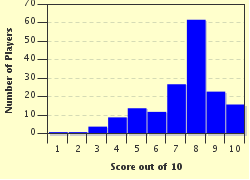Quiz Answer Key and Fun Facts
1. The white-tailed deer is native to North America.
2. One look at a white-tailed deer bounding away from you and it would be easy to see how the deer got its name. Which of the following examples is said to be the purpose this characteristic serves for the deer?
3. The age of a white-tailed deer can be determined by the number of points on the antlers or rack.
4. One of the most recognizable characteristics in the animal kingdom is the white spotted color pattern of the coat of a young white-tailed deer. What is a young deer most often called - particularly while their white spots are so apparent?
5. If you see a white-tailed deer without antlers you can say with all certainty the deer is a female deer or a doe.
6. During the summer months in North America the white-tailed deer has a covering over its newly grown antlers. What is this covering called?
7. White-tailed deer are very opportunistic feeders but their diet is plant-based. Leaves, grass, fruits, nuts, twigs and pinecones often are the deer's available and acceptable fodder. This diet will have them considered to be which of the following?
8. Before his antlers emerge from his skull you may be able to see bumps on the head of a male deer. These bumps have a particular name. What is it?
9. White-tailed deer seem to appreciate the human intervention of placing a block of material they can lick and enjoy. Whether placed by the would be hunter or the suburbanite homeowner, what is this (most often white) block of material?
10. As with most members of the animal kingdom, there can be intense competition among the male white-tailed deer for the privilege to breed with the female deer. When the bucks (or, male deer) lower their heads and push each other what is this called?
Source: Author
cowboybluedog
This quiz was reviewed by FunTrivia editor
guitargoddess before going online.
Any errors found in FunTrivia content are routinely corrected through our feedback system.

